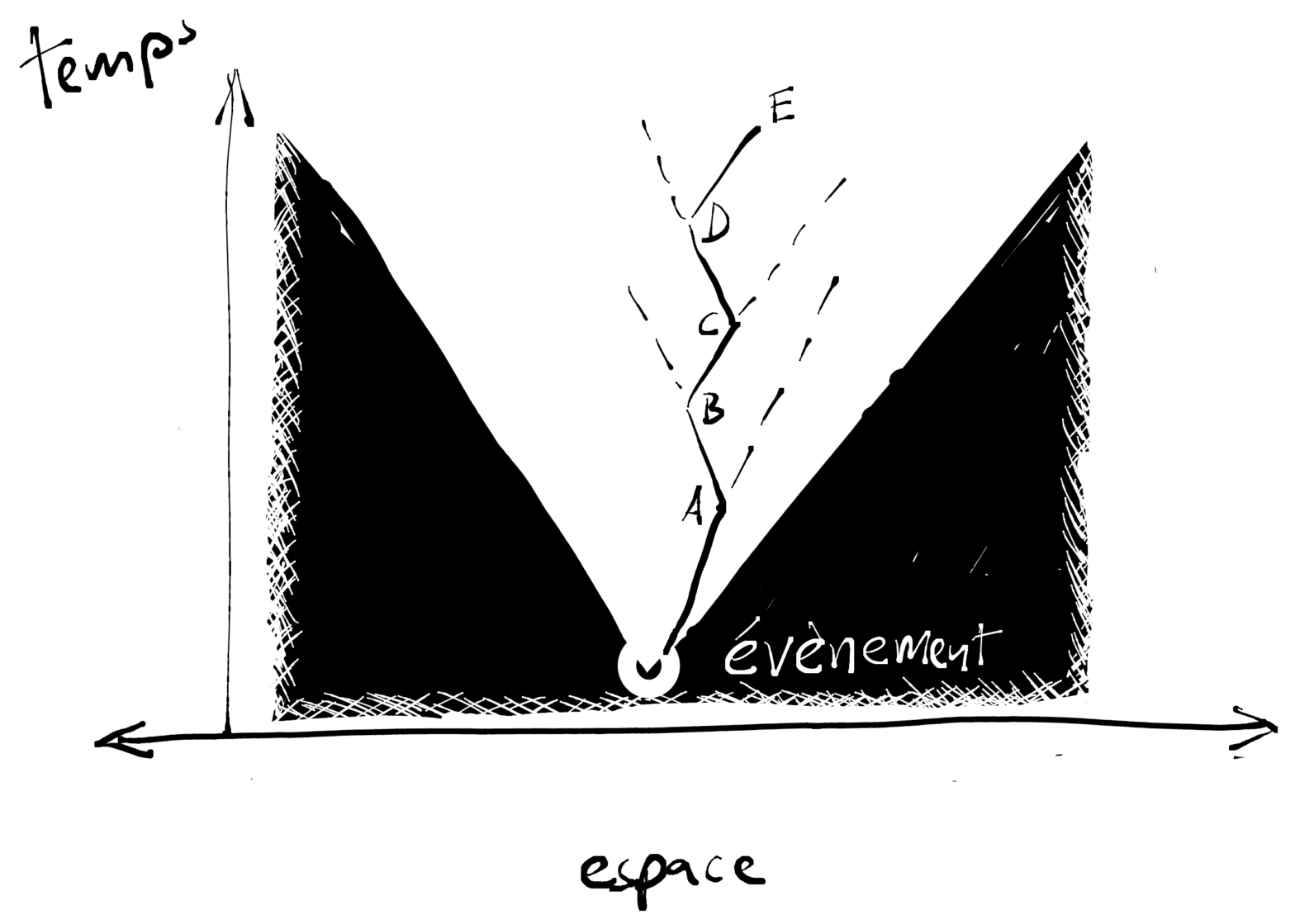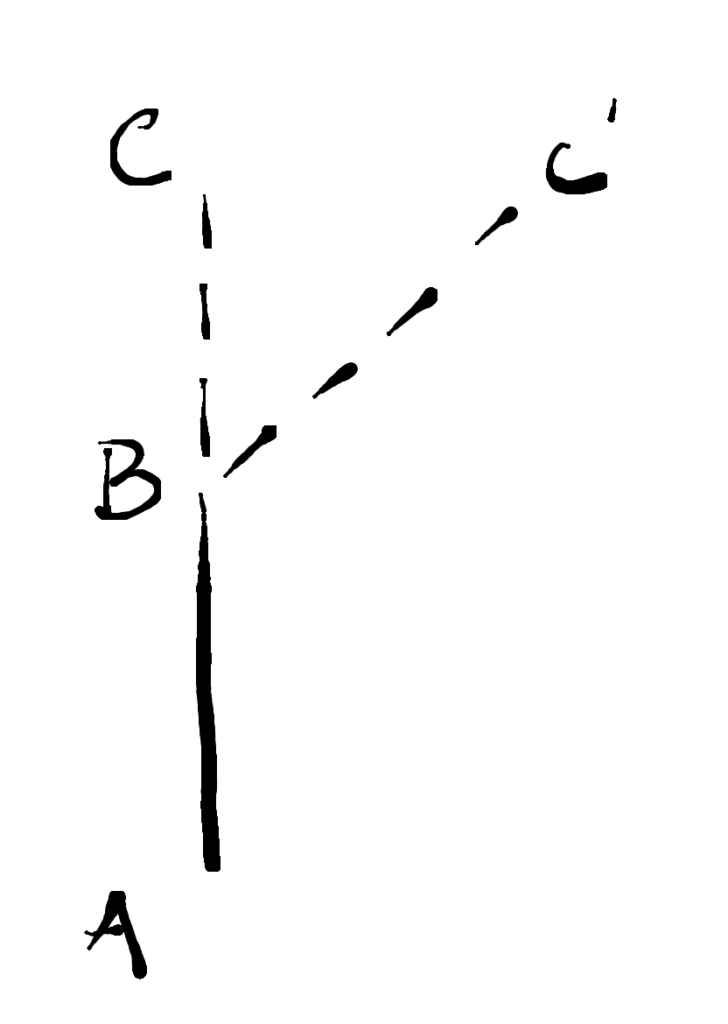
Let us assume the existence of A and B, two points connected by a straight line which, if it extends beyond B, lets us imagine C, a point located anywhere on this imaginary line. C, then, can be said “in the continuity” of A and B. We’ll arrive at point C if we do not deviate. C will happen if you don’t change direction, if you go straight, if we keep at it.
On the other hand, C does not happen if you branch off. If you give up the trajectory established by the alignment of A and B. If you refuse to extrapolate. After your master’s degree in social sciences, you got your PhD and everyone expected you to compete for a professorship; you chose to become a violin maker. After the birth of your second child, you were expected to buy a suburban house, but you left your husband and had a sex change.
Instead of C, we arrive at point C′.
The manuscript of the World of Yesterday, that Stefan Zweig sent the day before his suicide, begins with the following words:
“In describing the period before the First World War, in which I grew up, I hope to be as concise as possible in saying: it was the golden age of security. In our almost thousand-year-old Austrian monarchy, everything seemed to be based on permanence, and the state itself seemed the supreme guarantor of that permanence.”1
Every bifurcation thwarts an expectation. One can only fork if someone, somewhere, expects something. Yet expectations differ. One person will be surprised by the course of events, while another sees it as the logical consequence of all that happened before. To speak of a bifurcation makes no sense in the eyes of the laconic who tells us that he or she “expected it“. The contemporary historian no longer marvels at the path leading from colonial geopolitics and the social conditions of industrial Europe to the catastrophes of the first half of the 20th century. Even then, the Viennese essayist Karl Kraus reproached his fellow citizen Zweig for his excessive aestheticism and his lack of lucidity regarding the social struggles and the rise of ideologies. There are collective and personal expectations. Expectations of societies and of the individuals who constitute them. The institution that saw itself as the exclusive horizon of your joys and torments is offended to see you leave, but you have never considered it as more than a stage in your existence. Your family is shocked by your decisions, but you wonder how they managed to ignore who you are. Every change of direction only appears from a certain point of view.
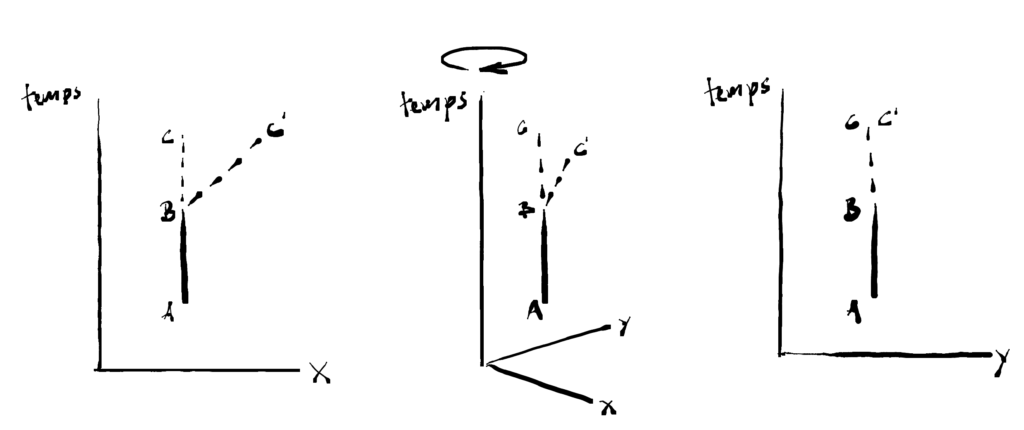
Let us assume that points A, B, C, and C′ each represent a state of the world at a given time. Let us imagine a very simple world, a world reduced to a single dimension, represented by the horizontal x-axis. A state of this world is reduced to the location of a point on this axis. The vertical axis represents time. In this model of world history, B’s position exactly above A means that the world remains in an identical state. For A and B both have the same x-coordinate; B is perfectly vertical to A; in other words, nothing has changed between A and B except the time that has passed and separates them. Everything leads us to believe that we will still be there at time C. We therefore speak of a bifurcation if we find ourselves, instead, at C′. But this is only a matter of perspective. Let us imagine a slightly more complex world endowed this time with two dimensions, x and y. Such a world can bifurcate on the x-axis and not move one iota on the y-axis. You notice that your bank account has been emptied by the hackers: the balance has gone down to zero, while the temperature in your office remains exactly the same; your goldfish is not affected by the cold sweat running down your back.
Any bifurcation occurs only from a restricted point of view ; it is limited to a few dimensions of the universe. “The world breaks down into facts. Something may or may not occur in isolation, and everything else remains unchanged”2 .
It would take not two, but an infinite number of dimensions to describe the state of our world at a given moment. We can call them x, y, z, xx, yy, zz etc. or simply x1 , x 2, x3 ,… to xn , because there are not enough letters of the alphabet to designate all the measurable dimensions of a state of the world, not to mention the immeasurable ones, about which I will remain silent here. Only some of these dimensions are affected by so-called historical upheavals. Against all odds, the revolutionary party has seized power, but you still can’t make ends meet. From the overwhelming majority of perspectives, C still coincides with C′.
But it is also almost certain that among the infinite number of points of view from which the world can be observed, there is at least one where its course forks. The sleeping village hums its obviousness, but on the floor of the inn, two long-time friends kiss for the first time and their lives shift into the unknown.
It is common in physics to think of the state of a system in terms of a position described by a set of coordinates x1 to xn . Rather than “state”, physicists like to say “phase”. When a system changes, it moves in phase space. The contents of a helium tank, for example, will have a given temperature (x1) and pressure (x2). If we heat the system, these two variables co-evolve and the system moves in both dimensions, sometimes to the point of annihilation: above a certain temperature, the cylinder explodes due to the effect of the pressure. From then on, there is no more cylinder and we cannot simply say that it has bifurcated. Nor will affirm such thing about the universe if it disintegrates tomorrow. Its disintegration would render null and void any observation about it; one would not be able to say of it that it is in a new phase or that its course has changed direction. It would have neither course nor direction.
In other words, the idea of bifurcation always implies an idea of permanence. Even if the course of the world bifurcates, it does so only within the framework of the coordinate system that describes the succession of its states. No bifurcation transports us into another world; to bifurcate simply means to make effective other possible states of a world where we already live. To designate the end of the world and its related events, we will have to find another word.

It is common in the social sciences to think of an individual’s state as a position described by a set of coordinates x1 to xn . If you are nineteen years old, for example, and yesterday you walked sixteen kilometers, we can represent these two aspects of your person by a single point in a two-dimensional space: age and distance traveled yesterday. It goes without saying that we would need many other dimensions to describe you. Every being, it is said, is infinite. But the infinity of a human being can also be thought of as a single point in a space with infinite dimensions.
Let us return to the two dimensions of a sheet of paper. If we take thirteen thousand individuals and ask each one his age and the distance he traveled yesterday, we will obtain thirteen thousand points in the space of these two variables. The Federal Statistical Office did this with thirteen thousand residents of French-speaking Switzerland3 . The respondents compose a cloud of points. This cloud has a shape: at the top and bottom, the points that make up the cloud are clearly closer to the left edge, i.e., closer to the zero of distance travelled. This means that people under 20 years of age, as well as people over 60, travel less distance per day on average than others. A general trend is therefore emerging. I have summarized it by the line4 which connects A to B. To assume that as they grow older, today’s young people will imitate their older contemporaries is to interpret this trend as a prediction: the vertical axis of the age of individuals becomes the axis of time, and the scatterplot becomes the crystal ball of the statistician. If you are nineteen years old, then, everything suggests that you will move more and more each day, on average, until you are about twenty-five, when this trend will be reversed. Gradually, your range of action will shrink slowly until you retire, and then rapidly from then on, until you come to rest in your grave. That is, at least, if you follow the general A-B trend.
In order to govern individuals or sell products to them, it is very helpful if they follow a general trend. You know, for example, that you have to show ads for travel destinations and vehicles to people under twenty-five. In the midst of a mobility boom, they will buy things and form habits. Even if they move less afterwards, their cars will need gas, tires and garages, and train regulars will consider upgrading their passes to first class. For those over sixty, on the other hand, it is better to put up ads for gardening tools.
The problem with prophecies lies in their tendency to come true. Marketing departments have taken a habit in reading our futures in scatterplots. The petabytes of information that humanity delivers to social media makes the predictions of the owners of these mdia more and more effective and detailed. In thousands of dimensions where the course of our lives is set, thousands of trends are emerging. In each dimension, we are offered the predictable, and therefore normal, continuation of our journey, but we are led, in doing so, to follow the general trend. Will the teenager who is fed with travel videos be able to assume that she prefers reading? Will the retiree still think beyond the fertilizers, flower pots and potter’s wheels ads that he keeps seeing in his Facebook feed? How do we find places that no one talks about online? Where do we find the resources to imagine ourselves beyond what we are shown? Bombarded with images, our imagination is atrophying. Tourist hot spots are overflowing with visitors, while so much on our planet remains to be discovered. Because our life courses converge, become rivers and dig furrows from which it becomes more and more difficult for each of us to exit5. Yet, for the time being, nothing prevents you, at 19 years old, from founding an aquaponic farm that will keep you busy for forty years. You will finally decide to leave it to your children, buy an electric bicycle and discover the world, riding longer and longer distances every day until you die, at the point B′ of your choice. Forking away from your destiny means not following the majority trend curve.
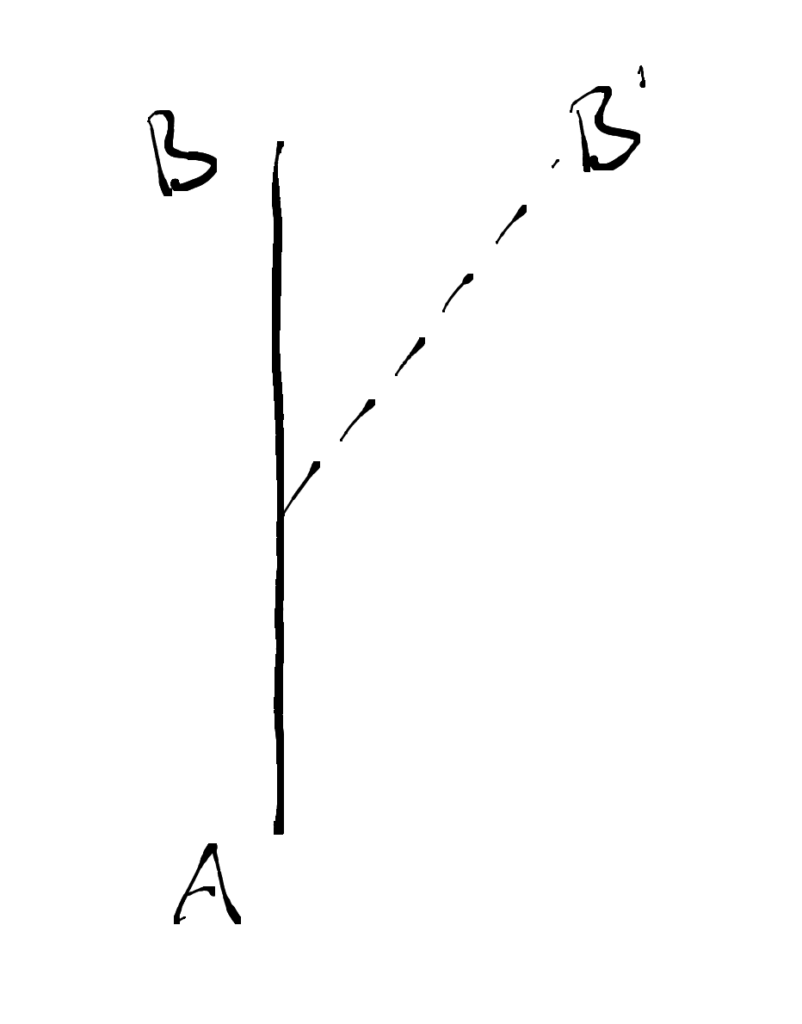
It is pleasant to escape one’s destiny. Especially if it crystallizes from the thoughtful extrapolation of someone else’s point of view, or from the interpolation of a majority trend. It is less pleasant to deviate from the promise made to yourself and to those you love. Betraying, betraying yourself, too, is a way of forking out. When you have sworn B and find yourself in B′.
One remedy is to change your perspective; prove to yourself that B′ coincides with B and that you have kept your word to at least some people in your life, or ate least in some way. The same strategy suits eschatologies of all stripes, those predictions based in faith alone. Those who predict the apocalypse that does not happen will tell us that it did happen without us realizing it, and that we are now living only in a metaphor of the scriptures.
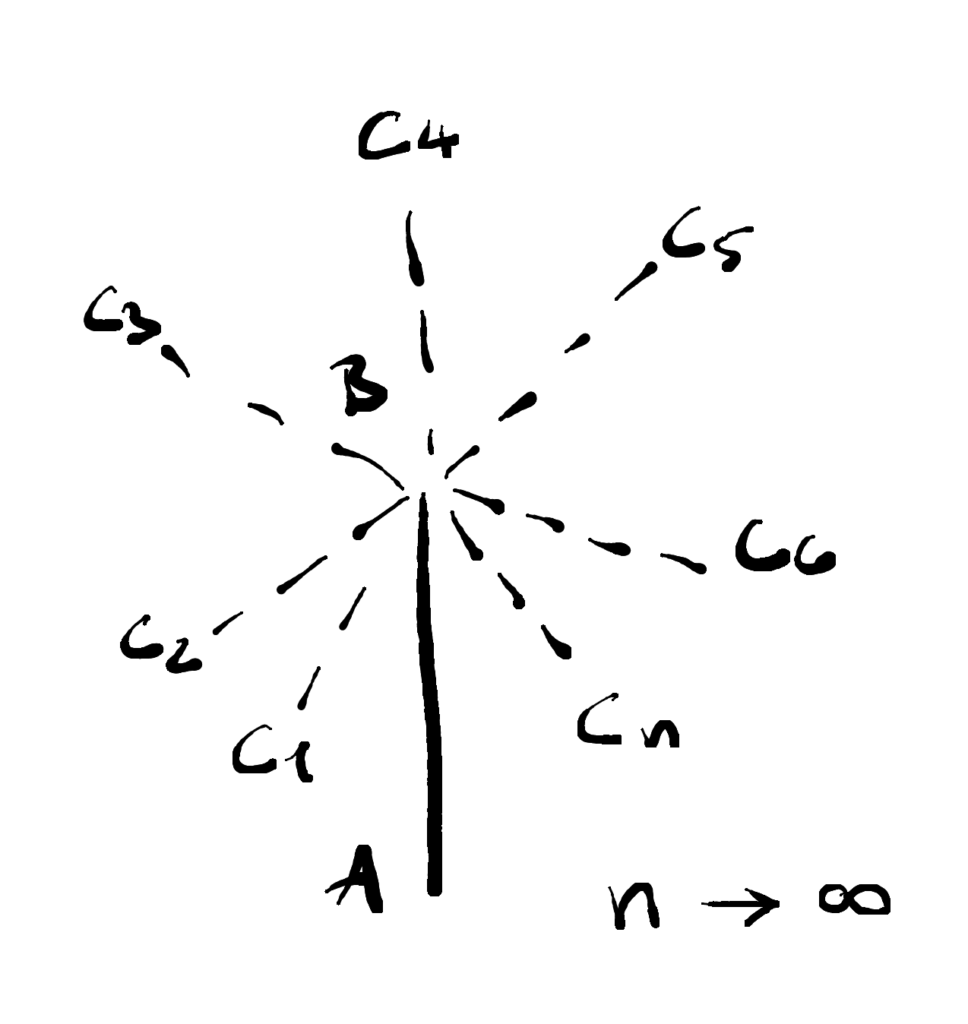
In this little bestiary of bifurcations, let us not forget, finally, all those which will not have taken place. Those that we like to call impossible6. The ones that open up at moment B but that you forbid yourself, or the ones you don’t manage to take. And again those that you don’t manage to choose. I have chosen to call hypertopia7 a present moment so full of possibilities that it no longer allows you to project yourself into an elsewhere, into a future, whatever it may be, like a black hole from which the light itself can no longer escape. Hypertopia is the disease of a world over-informed and crossed by injunctions to achieve. Hypertopia occurs when you become fully aware of the infinite number of possible outcomes of your existence that are open to you at every moment of your life. “Be yourself!”. Hypertopia threatens you if you take on board the expectations of others who tell you that you cannot remain in state B, whatever it may be, and that too many C’s appear to you. You suffer the terror of personal development. Hypertopia becomes unavoidable if you can’t make up your mind without being sure that you are choosing the best option. When n, the number of Cn approaches infinity, the superlatives nail you in place and time collapses into nothingness, into the absence of choice.
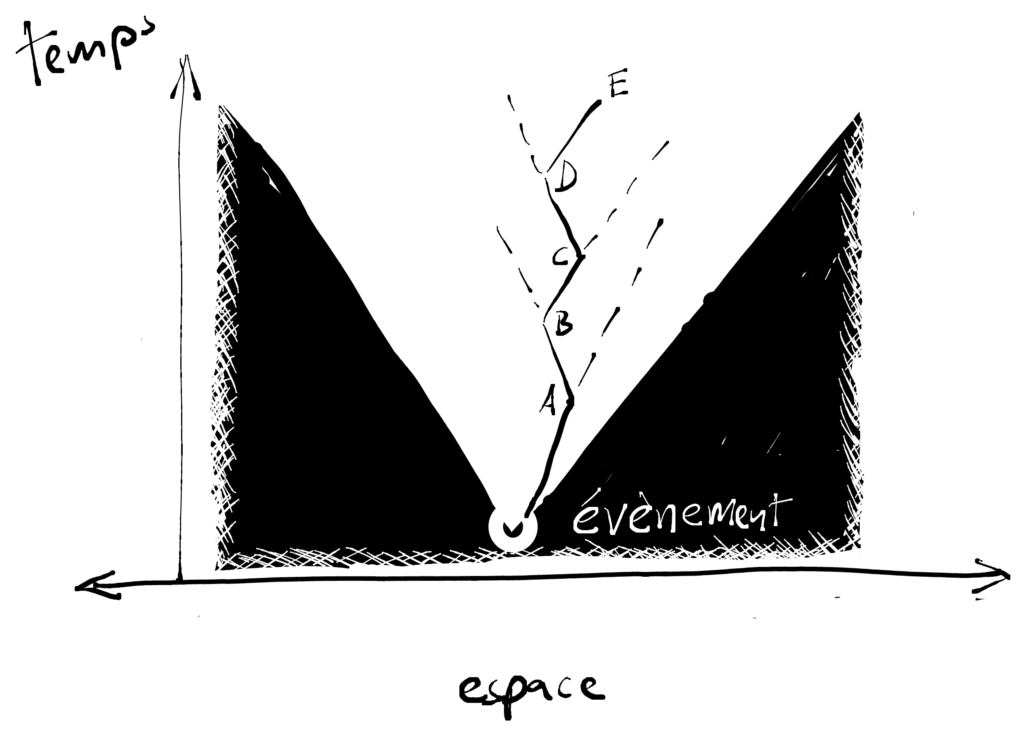
And while it is complicated but imaginable to extract oneself from hypertopia, there are bifurcations made impossible by the very structure of space-time.
In the 19e century, the physicist Hermann Minkowski introduced the concept of the light cone of an event. Let us imagine, one last time, a universe so simple that its space is reduced to one dimension. We can represent this universe on a sheet of paper and devote the other dimension – the vertical one – to time. Any event in this universe will be somewhere on these two axes. Any event will have repercussions on its environment. Its effect will perhaps propagate to the ends of the universe, but not at any speed. The theory of special relativity imposes a limit to the propagation of anything, whether it is particles with mass or pure information carried by photons: nothing can exceed the speed of light. It doesn’t matter if it moves in one or three dimensions. In our image, the movement of an object in our single dimension of space will be represented by a diagonal: the object moves to the left or to the right, while time keeps moving forward. The faster the object moves, the more the diagonal will be bent. If it moves at the speed of light, it will have traveled 300 km on the space axis for every thousandth of a second on the time axis, which is fast, but the diagonal cannot be more slanted than that. The light cone illustrates this limit: from any event, one can draw such a cone, inside which this event can exert an effect on space-time, and below which it can exert none. The angle of any bifurcation from an event A, or its consequent events B, C, D, E, etc., can never be less than that of the diagonal drawn by a photon. Whether or not it appears to the mind, any bifurcation from an event is necessarily located within its light cone. Apart from that, almost anything is possible. The cone of human action is much narrower than a cone of light. Our bodies with mass are dragging themselves through space-time. It would take an extraordinary amount of energy to intervene in person in Tokyo within an hour. Mankind gets around this limit by means of telecommunication, which allows us to influence distant things at the speed of electrons. Only the quantum entanglement, which stipulates the link between the state of two particles independently of the distance that separates them, allows us to dream of an influence freed from the limits of speed. But how can one fork in an entangled space-time?

Notes
This text was published the first time in French under the title “La bifurcation comme vue de l’esprit” in Bifurcation(s), Hélice Hélas, 2021.
1“Wenn ich versuche, für die Zeit vor dem Ersten Weltkriege, in der ich aufgewachsen bin, eine handliche Formel zu finden, so hoffe ich am prägnantesten zu sein, wenn ich sage: es war das goldene Zeitalter der Sicherheit. Alles in unserer fast tausendjährigen österreichischen Monarchie schien auf Dauer gegründet und der Staat selbst der oberste Garant dieser Beständigkeit.” Stefan Zweig, 1942, Die Welt von Gestern: Erinnerungen eines Europäers.
2 “Die Welt zerfällt in Tatsachen. Eines kann der Fall sein oder nicht der Fall sein und alles übrige gleich bleiben”, Ludwig Wittgenstein, 1922, Tractatus Logico-Philosophicus, §1.2 and §1.21. French translation: Gilles-Gaston Granger, 1993, Gallimard.
3 The study in question is the Mobility and Transport Microcensus conducted every five years. The figure in this text, which focuses on the age and daily distance of residents of Switzerland , is derived from the MRMT 2010 data, which resulted from the consultation of 59,971 households from all over Switzerland .
4 This curved line represents a 7e degree polynomial data model calculated with the stat_smooth function provided by the ggplot2 module for the R programming language. The hatched line is purely fictitious and represents a possible bifurcation from the model trend.
5 The philosophers Gilles Deleuze and Félix Guattari distinguish between smooth and striated spaces. A priori, the multidimensional space of possible phases that each human individual travels through is a smooth space: except in the dimension of time, you can move in any direction. However, if you keep on taking the same routes, this space becomes striated and it becomes more and more difficult to take alternative paths and escape routes.
6 It is essential to question the impossible. Why do you think it is impossible for you to do this or that? What stripe in the world forbids it? Your body? Your lifespan? The traces of the ancients? Or the day when, walking along the main street, you valiantly let go of your mother’s hand and ended up falling five metres down the road, on the side of fate?
7 I explain this term at greater length in an essay named after it, Hypertopia, published in 2019 by Editions de la Baconnière.
